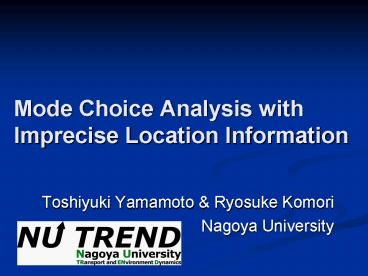Mode Choice Analysis with Imprecise Location Information PowerPoint PPT Presentation
1 / 22
Title: Mode Choice Analysis with Imprecise Location Information
1
Mode Choice Analysis with Imprecise Location
Information
- Toshiyuki Yamamoto Ryosuke Komori
- Nagoya University
2
Background
- Public transit such as LRT and Flexible bus is
regarded one of the alternatives for EST
projects, which improves the access and egress
conditions to public transit. - Centroid of TAZ is used as the origin and
destination in conventional mode choice models
3
Objective
- Effective use of large-scale person trip data to
investigate the effects of access condition to
the station and bus stop - by
- Combine information to get precise location
information - Develop a model to overcome the impreciseness
4
Chukyo Metro. Person trip data
5
Zone system
- True access 730 m
6
Zone system
- True access 730 m
- Access to zonal centroid 490 m
7
Zone system
- True access 730 m
- Access to zonal centroid 490 m
- If larger zone system is used 330 m
Larger zone system
8
Choice structure
- Nested logit model with
- Line haul mode in upper level
- Access and egress modes for train in lower level
Line haul
Train
Bus
Car
Access egress
Walk Walk
Walk Bus
Bus Walk
Bus Bus
Car Walk
Car Bus
9
Our approach egress
- Trip to governmental office, hospital and school
can be identified by information on destination
type - Multiple governmental offices are not located
together, and usually, one zone contain at most
one governmental office - The same thing applies hospital and school
- Note trips to small clinics might be included as
noise - Precise location and access to station and bus
stop is calculated by using GIS data
10
Destinations
- 20 zones with largest number of trip destinations
for each type of destination are used
Gifu City
Toyota City
Nagoya City
Yokkaichi City
Destination
11
Descriptive analysis
Relationship between egress and auto share
Auto share
Gov. Hospital School
Egress (km)
12
Gov. office 1981 to 2001
Auto share
Distance (km)
13
Hospital 1981 to 2001
Auto share
Distance (km)
14
School 1981 to 2001
Auto share
Distance (km)
This university operated school bus from station
15
Location choice in motorization
16
Our approach access
- About home-based trip, it is impossible to
identify the house, origin of the trip - Census data provide distribution of residents of
specific age/sex within survey zone - Access length is treated as probabilistic
variable in estimating the mode choice model
17
Calculation of choice probability
Access 240m Probability of living this city
block e.g.)20 yrs. Male ?3.3 40
yrs. Male ?7.7
Smaller city block
18
Calculation of choice probability
- Q(j) Probability of living in city block j
- Calculated by census and treated as known
- P(i j) Probability of choosing mode i given
that he lives in city block j - Precise access information is used as explanatory
variable - P(i) Marginal probability of choosing mode i is
calculated by P(i j)Q(j) - Unknown parameters to be estimated are only
utility function, which is indifferent among Q(j)
19
Effects of preciseness of egress info. (zone
system is used for access)
Coefficient estimate and t-stat. in parenthesis
- GIS based egress has
- Better log-likelihood
- Larger coefficient estimates in absolute value
20
Effects of preciseness of access(GIS base is
used for egress)
Coefficient estimate and t-stat. in parenthesis
- Proposed model has
- Better log-likelihood
- Larger coefficient estimates in absolute value
21
Comparison between access egress
- Use of bus access to bus stop from home is
dominant - Terminal mode for train egress has larger effect
than access
22
Conclusion
- Efficient use of conventional person trip data is
proposed, and confirmed by empirical analysis - Rail ridership can be increased by locating
closer to station, but move from 3 km to 2 km
doesnt mean anything - Egress from station is more important than access
to station

